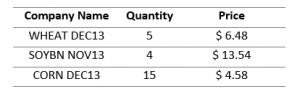- “U.S. wheat eyes biggest weekly gain in 14-months”
— let’s buy some wheat!
During the first week of our great trading game, I was totally comfortable with sitting at the bottom of the raking list with my poor -12.83% portfolio return, admiring friends make loans of money at +12.83% portfolio return…
This week I logged in my account in the same mood and suddenly something big happened – there are some numbers in green waving to me. Immediately, I thanked God and tried to seize the hope that finally appeared in my trading life.
As we all known by far, the price of wheat soaring into the sky this week, buoyed by expectations of strong demand from China (my lovely mother land) and Brazil. This huge increase leads my portfolio value to rise from $87,167.44 to $104,909.93.
- “Conservative angel VS. Adventurous devil”
— Buy more wheat and try to sell some corn and soybean
I can’t wait to share some transactions I did during the second week.
Firstly, motivated by the increasing tendency, I bought 9 units of wheat future and ended up with totally 15 units, which bring me $16,350 profit. I didn’t buy it as soon as I found the price is rising, instead I waited for small decreasing moment and then held some long positions (sorry for doing this during class, BTW once you are in the future market, it’s really hard to move your eyes from the big broad).
Secondly, I shorted and covered some soybean oil (about 1 or 2 unit) as some one in my mind told me I should try new things. It was kind of funny as I pretend to a professional speculator who buy low and sell high all the day. But it didn’t work well because of my patience. Anyway, good try.
 Thirdly, I tried hard to stop bleeding because of the decrease in soybean (always) and corn. As staying with a negative portfolio return for a long time, I realized it would be a long time to go back to the original price. So I decided to lose a little money instead of much. As there was a slightly increase of the prices. I sold them in two times, each time I sold half and set different market limit prices, for example 2 units at $4.5 and another 2 units at $4.53. As a result, I reduced my huge lost.
Thirdly, I tried hard to stop bleeding because of the decrease in soybean (always) and corn. As staying with a negative portfolio return for a long time, I realized it would be a long time to go back to the original price. So I decided to lose a little money instead of much. As there was a slightly increase of the prices. I sold them in two times, each time I sold half and set different market limit prices, for example 2 units at $4.5 and another 2 units at $4.53. As a result, I reduced my huge lost.
Lesson 1: Don’t make any decision as you see the price is going up. You can never be too patient to trade futures. Don’t hurry and spend some time to figure out what is the real trend of the market price.
Lesson 2: It’s OK to try something new but it’s highly that do some research first, to know what is it and what’s the main factors that will affect the price.
Lesson 3: Set a strict base line for the amount of lost. Once the lost is more that, you sell it no matter the price since it would cost you more in the future. The base line could be -5% of return and according to my experience -10% would be the maximum.
- News highlight “weather” & Signals for the coming week
News for this week mainly focus on the weather also it’s the main reason for huge increase in wheat market. But for how long would this trend last when the USDA releases the next crop report on Sept. 30th? I doubt it.
“Argentine worries” – It’s reported that there would be frost and droughts in Argentina, the southern hemisphere’s second-ranked supplier. This unfavorable weather conditions supposed to slow wheat seeding and affect the whole market.
“Chinese signal” – China’s domestic wheat prices have reached record levels, ending at 2858 yuan a tonne on Friday because of the droughts at the central and eastern regions of China. As the world’s biggest wheat consumer, China may increase imports to boost stockpiles and help curb record gains in local price, Shanghai JC intelligence Co. said.
“Abundant Soybeans” – the U.S. Midwest is forecast to remain mostly dry in the next three day, according to World Ag Weather. Drier weather this week will favor harvests, so it seems that to short soybean would be a good choice for this coming harvest season. Let’s wait for the crop report from USDA.
As for next week, I will do some research about soybean oil and try to take some right actions on it. Further more, I think it would be helpful to pay close attention to the crop report released by USDA since it would say a lot about demand and supply situations of the world. As for wheat, I think it may not keep the increasing trend like this week for too long, so I would also keep an eye on it. The most important thing is to read news every morning and trade after you have some ideas about the market. Trade early and trade often!
Mia






